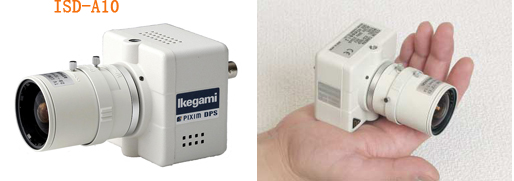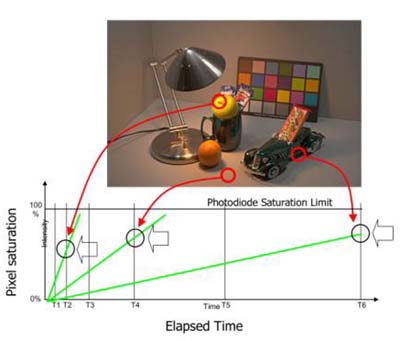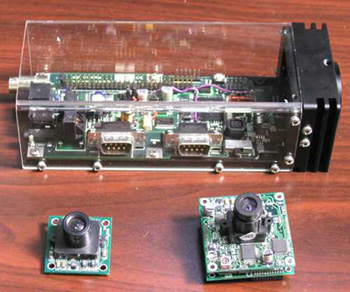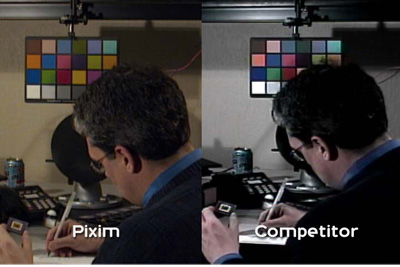Development and application of wide dynamic camera technology
PiximDPS imaging technology, which originated from Stanford University, has applied for 56 patents, 42 of which have become effective. The world-renowned camera manufacturer Ikegami uses this technology and some of its broadcast-level camera technologies to apply to surveillance cameras. In October 2005, the Ikegami ISD-A10 camera was launched. Once it came out, it has an excellent wide dynamic effect than traditional CCD cameras The true color reproduction and high definition have won wide acclaim from users in European and American financial institutions and security industries.1. Development process of wide dynamic camera
The security industry is a rapidly developing market, and the vast prospects and growth of this market can be seen through video surveillance. The video surveillance market includes products such as cameras, monitors, digital video recorders, audio and video matrices, and picture processors. Recent events around the world have contributed to the growth in demand for video surveillance products, especially for products with high-quality video images.
In the application process of surveillance cameras, scenes with large contrast between light and dark or backlight often appear. For safety reasons, CCD cameras are installed indoors and outdoors that need to be monitored. Since they often face multiple lighting conditions at the same location, the lighting conditions in many places are divided into mixed light of daylight and artificial lighting, and there is a contrast between light and dark at different times. Very large, backlighting, etc., such as in bank depository, entrances and exits of important places, etc., because the strong light entering from the window and the soft light from the ceiling fluorescent light may cause difficulty in capturing indoor and outdoor scenes The indoor and outdoor scenes with great contrast are clearly shot. However, for the security industry, it is required to shoot a clear picture under complex lighting conditions without losing details. Ordinary cameras are limited by the CCD sensitivity characteristics. When shooting images, the background will be too bright and the foreground is too dark, or the background is clear and the foreground is too dark and the foreground is suitable for the background. The traditional camera generally uses backlight compensation technology or is placed indoors or outdoors. A camera to adapt to the large light contrast, but the effect is not ideal. In response to this situation, a wide dynamic technology was born.
In 1977, Panasonic introduced the first generation of wide dynamic camera, its wide dynamic range is 40 times. In 1999, Panasonic introduced the second-generation super wide dynamic camera, which has a wide dynamic range of 80 times (48dB). In April 2005, Panasonic's third-generation super wide dynamic camera came out, and its wide dynamic range reached 160 times (54dB). At present, the wide dynamic technology is mainly controlled by some large foreign camera manufacturers. Although the technical methods of the various companies are different, the principle of using CCD to achieve wide dynamic is basically the same. The main technology of WDR is to use a special DSP (Digital Signal Processing) circuit to expose the bright part to the most appropriate shutter speed, and then to expose the dark part to the most appropriate shutter speed, and then perform DSP processing on the two images In combination, the bright and dark parts can be seen clearly, which requires a very high technology to minimize the loss of color and clarity. However, due to the limitations of CCD characteristics, the wide dynamic range of the camera can be up to about 60dB.
In October 2005, Ikegami introduced the ISD-A10 ultra-wide dynamic camera using Pixim's DPS imaging technology, which has a dynamic range of up to 120dB and has very good color reproduction and clarity. It marks a huge breakthrough in WDR technology, and a new generation of WDR cameras has taken a big step forward at the starting point of a higher layer.
2. Pixim's DPS technology super wide dynamic camera comes out

At the ASIS International Security Exhibition in Orlando, Florida, in September 2005, a new CMOS-based Pixim's DPS DigitalPixelSystem® (Digital Pixel System) CCTV camera gave a refreshing feeling. Ikegami Ikegami, a manufacturer of professional radio and television cameras and CCTV cameras, introduced its first PiximDPS camera HyperDynamicISD-A10, which became the highlight of the exhibition. And after the exhibition, it was widely welcomed by American and European banks and financial institutions.
The following image shows the comparison between Pixim camera and ordinary CCD camera in the same scene.

This time the Ikegami company combined its leading low-vertical flare and backlight compensation, color adjustment and other technologies with Pixim technology in the field of cameras to launch the super dynamic ISD-A10 camera.
In normal or wide dynamic range scenes under any light conditions, Pixim's DPS chipset is closely arranged, easy to form a certain shape, and can take very high-quality images. When shooting actual images with existing simulation technology, due to the continuous change of light and the limitation of accurate color restoration of objects, defects such as poor object recognition and poor color reproduction of the image appeared, and the continuity and accuracy of Pixim imaging technology overcome these defects. The DPS image sensor converts the light signal into a digital signal on each pixel, so that each pixel has an independent and optimized exposure time to produce a high-quality, high-color accuracy image.
3. Pixim's DPS technology background
Pixim has developed a patented DPS imaging technology superior to traditional CCDs, which marks a breakthrough in basic principles of image technology. DPS technology was developed in 1993 by Abbasel Gamal, a professor of electrical engineering at Stanford University, and his doctoral student David Yang (Yang Xiaodong), and was later authorized to Pixim, a company founded by Dr. Yang Xiaodong in 1999. Since then, Pixim has applied for 56 patents on DPS concepts and technologies, 42 of which have become effective.
DPS imaging technology has transformative significance in the process of video camera capture and image processing. Using this technology to shoot high-quality moving and still images exceeds any other existing technology. The so-called DPS platform, by combining image capture and processing in an optimized system, Pixim's imaging system has unparalleled functions. Pixim provides a complete digital imaging system including an image sensor, image processor, camera reference design method, software and key algorithms, making the camera easy to develop and design and form a high-quality, high-performance camera.
Fourth, the basic principle of Pixim's DPS technology
The core invention of DPS technology is to convert the optical signal to a digital signal at each pixel point when capturing an image-from analog to digital conversion ADC (analog-to-digitalconverter), which minimizes signal attenuation and chroma-luminance crosstalk , So that the sensor provides the best and independent exposure times for each pixel. Once the data is captured in digital form, a variety of digital signal processing techniques are used to reproduce the best image. Even in high-dynamic-range scenes under extreme lighting conditions, accurate and low-noise images can be taken.
Pixim's DPS technology uses a technique called "multi-point sampling", which is used to collect information to achieve high-quality images and a wide dynamic range. In a single captured image (typically 50 to 60 times per second in video), each pixel is independently sampled multiple times non-destructively. The imaging system determines the optimal sampling time and stored pixel information before the pixel is saturated, and no longer retains additional charge. In the chart below, the bright pixels are stored on the time axis T2, the most recent sampling time before it reached 100% saturation.

The dark pixel accumulates charge a bit slower and will take more time until it is sampled and stored at T6. The stored information values ​​(intensity, time, noise compensation) captured by each pixel are processed in parallel and then converted into high-quality images. In contrast, other technologies set an exposure time per frame and sample each pixel at the same time. As a result, some pixels of the image are underexposed (too dark) and some pixels are overexposed (too bright).
Pixim's first D2000 video imaging system based on DPS technology consists of a digital imaging transmitter and a digital image processor. Digital imaging sensors and digital image processors are very similar to human eyes and brains, and two-way real-time interaction captures the highest possible image quality. Just as a person walks into a dark house, the brain directs the eyes of the person's eyes to find the light, and the digital image processor loads a new code into the sensor to change not only the exposure time but also the actual image capture calculation method. The result is an optimal image under special image characteristics and bright conditions.
Because each pixel has its own analog-to-digital converter, the generated information is captured and processed independently, and each pixel plays a role in its camera. In the pixel arrangement position of the image sensor, the exposure time of each pixel is adjusted to deal with unique light conditions. A camera manufactured based on the DPS system platform essentially has thousands of independent camera units, and each camera unit creates the best image possible. These images are then combined to create a high-quality video frame or picture. As imaging technology continues to approach the entire digital system, Pixim's DPS technology will provide the basis for image capture and processing for high-quality video cameras and cameras.
5. Performance comparison between traditional CCD camera and Pixim camera
The development of PIXIM technology relies on a large number of digital-to-analog conversions to reduce the glare of strong light on the picture. Each pixel is matched with a digital-to-analog conversion, so the bright light pixels reduce the exposure amount, and the low light pixels increase the exposure amount instead.
PIXIM technology promotes digital video with a wide dynamic range. What you see with your eyes is not what you can capture, at least not through digital video. The biggest problem with the CCD image sensor is that the captured image is far less effective than the image seen by the eye. The eyes can be automatically adjusted to apply continuously changing light and see the most ideal image. When the eye sees a scene containing bright and dark light, it can reduce the sensitivity to strong light areas and increase the sensitivity to the details of dark objects and shadows.
A CCD sensor can adjust the bright and dark scenes, but cannot adjust the two brightness at the same time. So when you walk around the house with the camera, the exposure is good. But if your lens is facing the glass under sunlight, this camera will not work very well, you can not see anything outside. Conversely, bright objects in the foreground will drown in dark objects in the background. Everything in the shadow becomes black.
The limited brightness range does not affect the functions of home cameras, and is often used in movies to achieve artistic effects. But this effect is undesirable in the security camera market. If the bad guy is hiding in the shadow, you will not be able to recognize it. If details in the scene illuminated by strong light are lost, valuable clues may be lost.
PIXIM solves this problem with a new CMOS sensor technology-DPS. Although the foreground is bright, the shadows are still clearly visible. Objects in the bright light area have not been lost. The example of the two-picture comparison of PIXIM camera and CCD camera is vivid and convincing, and is considered to be trustworthy in the security camera industry.
In the photo below, the PIXIM image sensor is seen on the left, and the Sony CCD sensor is seen on the right. Because the CCD system uses simulation technology, many components are composed of the rough three phases. Conversely, the PIXIM system is digital, and has a matching chip to observe and process pictures on a pixel-by-pixel basis. The random ARM-100 processor allows camera manufacturers to choose PAL or NTSC output and dynamically adjust the sensitivity.

Wide dynamic range WDR

Pixim-based cameras can see the details of indoor images and outdoor environments, including pictures of bad people. CCD-based cameras, outdoor images are not available, including people present.
Color accuracy

Cameras based on Pixim technology show better color fidelity and clarity. Note the difference between the color of the card table and the card, and the contrast of the text on the table.
Extreme light environment

There is strong light in the jewelry store, the Pixim camera is not affected by the strong light, and the indoor and outdoor images are clear.
White balance

In any light, Pixim-based cameras take more vivid pictures than other technology cameras. Even under typical (tungsten) lighting conditions, Pixim cameras display better image quality. The CCD camera has defects in white balance and accurate color. Note that the Pixim camera gets a color map of all the details, the details on the shirt and the color accuracy of the image on the wall.
Sixth, the application of wide dynamic camera
At present, there are many types of wide dynamic cameras in the surveillance camera market. Many products have been developed from the first generation to the third generation. Toll booths, hotel office buildings, entrances and exits of important facilities, and other places with large changes in light. But now many wide dynamic cameras use synthesis technology. If the technology is not processed properly, it will cause poor image restoration ability, easy distortion of colors, double images, and poor definition. With the development of CCD wide dynamic technology and the application of new CMOS technology, camera manufacturers will bring more and better wide dynamic cameras to the market.
In the CCTV monitoring system, the front-end camera occupies a very important position. When choosing a wide dynamic camera, you should start from the following aspects:
1. According to the actual application place and monitoring target, select the camera with parameters, indicators and functional requirements.
2. Through sample demonstration, verify that the marked product parameters, indicators, and functions are consistent with the product, and whether the sharpness, wide dynamic effect, and color reproduction of the captured image are actually measured.
3. Choose a highly reliable camera. After the monitoring system is built, if the quality and reliability of the camera cannot be guaranteed, it needs frequent maintenance, adjustment or operation for a period of time. The image quality is reduced and damaged. These losses to the user may exceed the cost of purchasing the camera.
4. Choose a good camera should be equipped with a good lens, so as to show the best results.
The application of PiximDPS technology will undoubtedly bring vitality to the market of wide dynamic cameras, but it can really bring the technology to the fullest, depending on the technical strength of the manufacturer. Just like many manufacturers can use CCD devices to produce cameras, but the technology leader is still a few well-known brand manufacturers.
The price of the Pixim chip camera represented by the Ikegami ISD-A10 camera is not higher than that of the traditional CCD camera. It has been available since the end of 2005 and has been widely recognized and praised by many users around the world for a long time after use and observation.
LED tube light commonly known as straight tube lamp, is a traditional fluorescent lamp replacement, embodied in energy saving and environmental protection in two areas. Size installation and traditional fluorescent lamps the same, but the principle of light is the use of LED semiconductor chip for light. According to the shell material is divided into two categories, one is glass, one is aluminum and PC.The luminous efficiency around 90lm / W ~ 200lm / W. Applications in large factories, production workshops, workstations, office, shopping malls, underground parking, hospital , school , family.
LED Tube Light,T8 LED Tube Light,T5 LED Tube Light,T5 Socket T8 LED Tube Light
Shenzhen Ri Yue Guang Hua Technology Co., Ltd. , https://www.ledlightinside.com